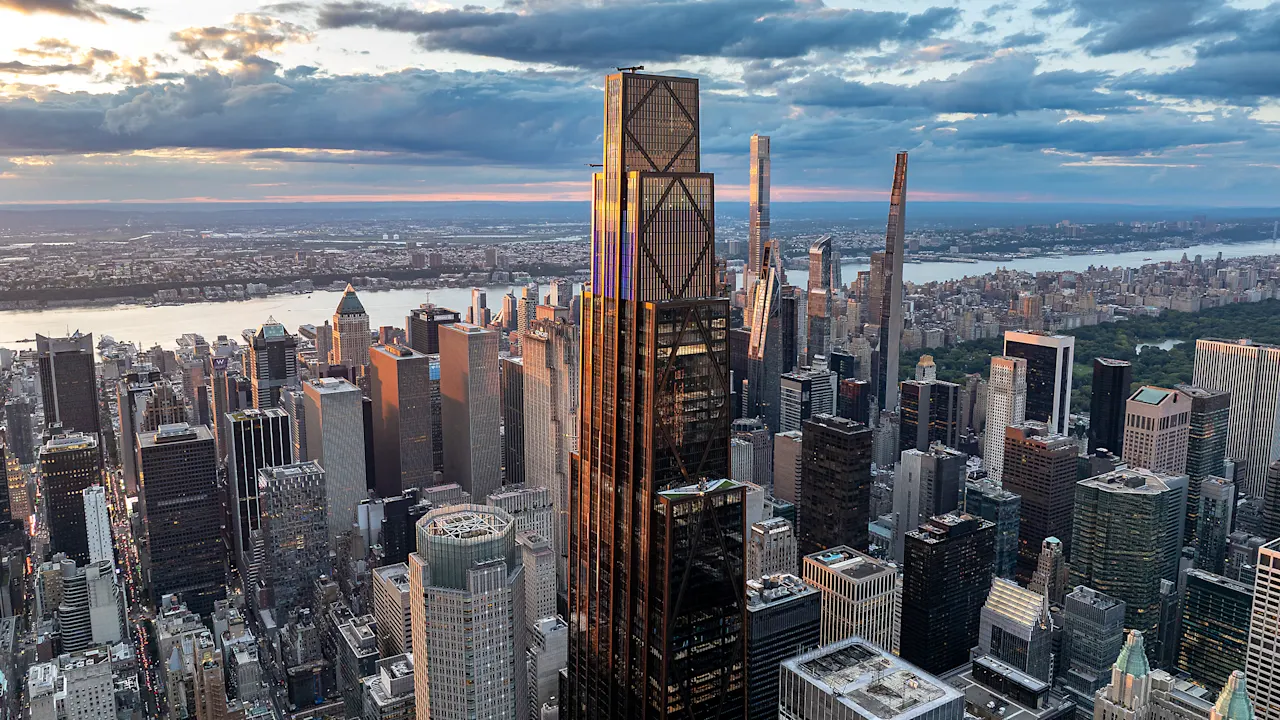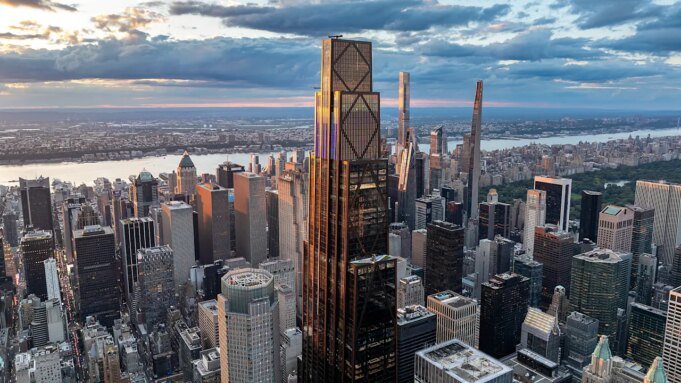JPMorganChase made a $3 billion bet on office culture

“Welcome to the future!”
David Arena, head of global corporate real estate for JPMorganChase, is standing on a sweeping staircase in a soaring travertine-clad lobby addressing a crowd. He’s there to welcome visitors to the ribbon cutting of 270 Park Ave., the banking behemoth’s new global headquarters in Manhattan.
Behind him, an American flag hitched to a fluted bronze mast flies vigorously (it’s propelled by an artificial breeze that required a remarkable amount of fine-tuning). Standing next to him are the people who helped design and build the $3 billion, 2.5 million-square-foot supertall: JPMC CEO Jamie Dimon, British architect Norman Foster, developer Rob Speyer, New York Governor Kathy Hochul, and New Age author Deepak Chopra.
For the leaders at JPMC, 270 Park is a big bet on the idea that working from an office is a competitive advantage in a business landscape that is rapidly changing. New technology, a shifting regulatory landscape, and geopolitical change are all coming to bear on the future of the financial services industry. A world-class office building, they believe, will provide an anchor in a tumultuous moment, and for many years to come.
Ask the team behind 270 Park and they’ll tell you that the new HQ is meant to be a joyful, productive space. The goal is to make workers healthier in mind, body, and spirit—and therefore equipped to do their best work efficiently and effectively. “It’s a vessel where abundance flows naturally,” Chopra proclaimed when he took the podium after Arena.
(Photo: Nigel Young, courtesy of Foster + Partners)
The office of the future, built for today
JPMC began plotting its headquarters seven years ago. While it remained steadfast in its vision for the future of the office, the nature of work has transformed substantially since then. The pandemic forced many people into remote work due to health and safety concerns, and once the Slack and Zoom growing pains subsided, many folks realized that they actually had better work-life balance, saved money on commuting, and just generally felt happier and healthier while working from home—all while still getting the job done.
For many, the drawbacks of remote work, like less access to equipment and feeling disconnected from company culture and team members, could be solved with a hybrid arrangement. Of the people who are able to perform their duties remotely, 52% prefer hybrid work, according to a recent Gallup poll, with just 26% preferring exclusively remote work and 22% desiring fully on-site work.
These shifts provoke a question many office workers ask: If an office isn’t technically required in order to do the job, then what is the office for? As with all headquarters, particularly on Park Avenue, the city’s glass-and-steel canyon of corporate skyscrapers, they are symbols. JPMC’s new building is a symbol not only of corporate ambition but also civic aspiration.
Occupying a full city block, 270 Park Ave. is the first major office building to be constructed since the COVID-19 pandemic. It’s the centerpiece of a JPMC microdistrict Dimon has assembled in the heart of Midtown Manhattan. Symbolically, and practically, it depicts a vision for the future of the financial sector in New York—one that is as brawny and commanding as Foster + Partners’ formidable skyscraper, which is held aloft by a massive bronze-clad base whose columns taper into six fan-shaped forms.
According to a report in The New Yorker, the base alone required more steel to build than the 52-story building that was on the site before, the elegantly proportioned and assuringly reposed Union Carbide tower by SOM architect Natalie de Blois. Arena described the building as “a beacon of American strength.”
(Photo: Nigel Young, courtesy of Foster + Partners)
An office “you’ll never want to leave”
Dimon has been one of the most vocal supporters of returning to the office five days a week. His employees, however, have not always agreed. They have signed petitions asking for more flexibility, and unionization efforts are underway in response to the policy. But pushback doesn’t seem to be making a difference. According to a recording obtained by Reuters of a JPMC town hall in Columbus, Ohio, Dimon responded to an employee asking about the petition: “Don’t give me the sh*t that ‘work from home Friday’ works.” Later he told CNBC that employees “should respect that the company is going to decide what’s good for the clients, the company, etc., not an individual. . . . And so they can get a job—and I’m not being mean—they can get a job elsewhere.”
At the press conference, Hochul praised Dimon for sticking with his commitment to build 270 Park during the pandemic, at a time when doom-forecasting pundits spelled crisis for Manhattan’s future amid a sluggish return to office and the ripple effects from less foot traffic in business districts. “He said come back to the office, I’ll give you a place you’ll never want to leave!” she crowed.
I wondered if she may have been alluding to the business and its relationship to the city. Her official statement said the building “reaffirms New York as the world’s financial capital.” Over the past few years, the financial sector, which is responsible for a quarter of the city’s economy, has been shifting investment from New York and California to Sunbelt states. JPMC now employs more people in Texas than New York.
Still, the bank has emphasized its commitment to New York. “The opening of our new global headquarters is not only a significant investment in New York, but also a testament to our commitment to our clients and employees worldwide,” Dimon’s statement about the opening reads. “We are strengthening our ability to serve our clients and communities—locally and globally—for generations to come.”
There’s ample symbolism of this sentiment in the architecture. In his remarks, Foster described how the building is anchored into the bedrock below and that its form—which in the skyline resembles either a slender tower or an elongated, bulky ziggurat depending on your vantage point—is derived from the urban fabric and zoning code. “I’ve always admired the grid, and it is inseparable from the grid,” Foster remarked. “There’s no computer wizardry. It is four square and rooted in tradition.”
In fact, 270 Park Ave. is the first project to result from the East Midtown Rezoning, a Bloomberg-era idea finalized in 2017 to attract and maintain business in the area. It also created a funding mechanism to improve the neighborhood’s public realm and mandated indoor or outdoor public space for new development. At the new headquarters, this element takes the form of a leafy public plaza on Madison Avenue furnished with concrete benches, movable jet-black Bertoia chairs and Saarinen tables, and an installation by Maya Lin composed of tessellated slate-gray stone that apparently references Central Park schist.
Along Park Avenue, there are long cascading steps into the building that give the illusion of a plaza but nudge passersby to keep it moving; the steps are far too shallow to sit on, unlike at the Seagram Building a couple of blocks north. Arena described 270 Park’s open space and public art as “our gift to the city,” as though it were benevolence and not part of the deal NYC struck with JPMC to allow the company to build to an astounding 1,388 feet. Taller than the Empire State and Chrysler buildings, and with a scintillating LED light installation by the artist Leo Villareal at its crown, 270 Park is certainly making the presence of those gifts known.
(Photo: Nigel Young, courtesy of Foster + Partners)
The quantified workplace
This idealistic vision of both JPMC and Midtown—the hive of abundance within the prosperous city—hinges on a critical element: people. The building is a recruitment and retention tool that plays into the elements that have been scientifically proven to increase quality of experience, like ample natural light and clean air, as well as amenities designed to bring individual fulfillment to employees. To that end the interiors are designed to promote social, functional, and restorative activities among all teams that will use the building, which will encompass 10,000 employees.
“Really you’re solving for people,” Stefanie Shunk, a design director at Gensler, told me after the ribbon cutting. The firm was responsible for 1.7 million square feet of workspace spread across 30 floors of 270 Park Ave., which includes conference floors, amenity spaces, health and wellness floors, and executive suites; the firm SOM designed the building’s eight trading floors. “We’re all high-performing individuals now,” Shunk continues. “And with an Oura ring, or different devices, we’re measuring ourselves as well. So what does that mean? Mindsets have shifted to how we think about what optimizes our day.”
Shunk and her team conceived of the work floors from a perspective of “experience density” so that employees would never feel like they’re in a vast expanse or too far from amenities. The elevators on each work floor open to a double-height communal space, which resembles a café. Lactation and well-being rooms (including prayer rooms with foot baths) are located off the communal spaces. Providing sensory variety—from a dead-silent recharge room to an energetic shared space and everything between—also guided the strategy.
The workspaces are flexible, built with the assumption that the business and its teams will change. They’re constructed on raised floors, arranged on a modular grid, and the walls are demountable. “We wanted this space to live over time,” Shunk says. “It wasn’t about a 10- or 20-year lease; this is a 100-year-plus building.”
While the workstations are all open, Gensler devised seating arrangements and interior details that help each individual feel like they have more personal space. Along the windows, designers dispensed with private offices so that more daylight can permeate the space. Instead, they clustered workstations in groups of two and four, reducing the number of middle seats as much as they could. “People like to feel like they’re in their own space,” Shunk says. “We just didn’t want to see a run of 8, 10, 12 desks.” For people with workstations near high-traffic areas, custom glass partitions are installed so their backs are protected.
The primary detail that changed due to the pandemic was the addition of video chat rooms designed for one to two people; before, the smallest conference rooms were huddle spaces intended for four to five people. Gensler designed the video chat rooms to include virtual desktops to ease moving from their workstation to the room, and tables that are contoured to give each person in a meeting a more equitable experience on-screen. Part of the value of more of these rooms is to protect the acoustical environment in the open areas. The reality of work today is that even if you are in the office, you’re likely working with someone who is not there and so video calls are now routine.
“What really changed from the pandemic is we care so much more about the individual and designing to the outer edges of what people need,” Shunk says. “It used to be ‘Design for the 80%,’ and now it’s ‘Let’s solve for the majority.’”
(Photo: Nigel Young, courtesy of Foster + Partners)
A one-stop-shop for everyone
Foster describes the building as “a city within a city” where presumably every activity someone might need to do throughout the day can happen within 270 Park’s walls. One space that JPMC is particularly proud of is “The Exchange,” a three-story community hub Foster + Partners designed. It includes an expansive space for parties and corporate gatherings, plus a Danny Meyer-curated food hall with 19 restaurants and cafés (one is in an Airstream and another is in what looks like a classic green NYC newsstand). Foster + Partners designed a lavish client center at the very top of the building, with 360-degree views of the city.
As I watched the video fly-through of the building’s interior that played during the ribbon-cutting ceremony, I was wowed by the wealth of spaces and the lengths the real estate team took to make the office come off as hospitable. I would very much like to work from a plant-filled office, with daylight and views of the metropolis. (Although I could do without the mandatory biometric scanning employees will need to do to enter the building; instead of badges, JPMC will use their palm or fingerprint.)
The concentration of amenities and activities within the building reminded me of another architect who frequently spoke of his developments as a city within a city: John Portman, who constructed epically scaled hotels in beleaguered downtowns to spark economic development. But Midtown Manhattan now is not Atlanta in 1985. This August, pedestrian activity in the city topped pre-pandemic levels. One of the great pleasures of being in New York City is experiencing everything it offers in its entirety, not merely a microcosm designed in its image to keep people in a single location.
According to Chopra, achieving an abundance mindset involves reframing your thoughts to focus on everything you currently have instead of obsessing over what you lack. In the case of JPMC, that’s likely the freedom to work remotely. Employees are steadily moving into 270 Park, with full occupancy expected by the end of the year. As they adjust to their new office, they will determine whether perks like imported taps that pour a perfect pint of Guiness, an app that enables them to order lunch to their desks, a signature scent piped into the air, and lighting that adjusts with circadian rhythms are the acts of corporate generosity or hallmarks of a gilded cage.
已发布: 2025-10-24 11:00:00











